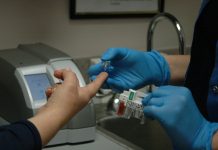
No. People with diabetes can eat regular sugar containing hard candy when they feel low blood glucose symptoms. A quick dissolving and absorbing food with 15 grams of carbohydrate per serving are best. A better alternative is 4 to 6 ounces of fruit juice, milk or regular carbonated soda, 1 tablespoon honey or syrup or 6 saltine crackers. Glucose tablets are available in most pharmacies.
A person with diabetes takes insulin or pills prescribed by their doctor to control their blood glucose within a desirable range of approximately 70 to 105 milligrams per deciliter. These medications combined with a diabetic nutrition therapy and exercise keep blood glucose within that desirable range. However, when a person with diabetes either skips a meal, eats too little, drinks alcohol without eating, gets too much exercise or takes more than the prescribed dose of medication, low blood glucose (hypoglycemia) is more likely to happen. Their blood glucose drops below the person’s fasting range, usually below 70 milligrams per deciliter. Your body uses your blood glucose as its main fuel. When your blood glucose drops, your body will start sending you warnings in the form of symptoms.
The symptoms are shaky, sweaty, hungry, headache, dizzy, mood change, blurred vision or pale. If ever in doubt of whether a person with diabetes is having low blood glucose, test their blood glucose using a blood glucose meter. If you are not able to test their blood glucose, offer them one of the following foods rather than do nothing or wait: 4 to 6 ounces fruit juice or milk; one-half can regular carbonated soda; 1 tablespoon honey or syrup; 6 saltines. Within 15 minutes, the person with diabetes should feel better. If they are not better, repeat the same amount of food. If the diabetic still doesn’t feel good, his / her blood glucose probably wasn’t too low. He/she should then see a doctor. Never force food or liquids down a person who is groggy or unconscious. You may be pouring the food or liquids into their lungs rather than into their stomach. Get a person with diabetes that is groggy or unconscious to the nearest hospital immediately.
You can feel a person’s skin if you suspect a reaction. Their skin will feel wet, cool and possible clammy. Feel your own skin now. Your hand should slip smoothly over your skin. It should feel warm and dry unless you have been out in hot weather or exercising heavily.
If a person with diabetes has frequent or regular occurring low blood glucose, he/she should see their doctor to change the dose of insulin or pills. Low blood glucose on a regular basis does not happen to most people with diabetes. People with diabetes and their family should know the symptoms and treatment for low blood glucose.



